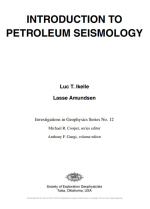Добрый день, Коллеги. Важное сообщение, просьба принять участие. Музей Ферсмана ищет помощь для реставрационных работ в помещении. Подробности по ссылке
Introduction to petroleum seismology / Введение в нефтяную сейсмологию
Seismology is a branch of geophysics that aims for the understanding of earth’s interior, through the analysis of ground motion. The science of seismology began with study of naturally occurring earthquakes. Seismologists soon found that seismic waves produced by earthquakes contained valuable information about earth’s interior (crust, mantle, and core). Later they discovered that similar but much weaker man-made seismic waves could be used to interpret the shallow structure of earth, to locate minerals, water, and petroleum resources. Thus, a special branch of seismology known as petroleum seismology and the associated seismic exploration industry were born. To distinguish between petroleum seismology and the study of naturally occurring earthquakes, we will call the latter earthquake seismology.
Although both branches of seismology are based on study of the generation, propagation, and recording of elastic waves in the earth and of the sources that produce them, the job of a petroleum seismologist differs significantly from that of an earthquake seismologist. The advent of 3D seismics — which can produce an enormous amount of detail about subsurface geology and hydrocarbon reservoirs — has changed the job profile of a petroleum seismologist tremendously.
No longer isolated to the domain of academic, postdoctoral, or postgraduate researchers or of similarly trained specialists in research centers of the oil and gas industry, petroleum seismologists are widely accepted today as key players in finding petroleum traps and even producing oil and gas more efficiently from complex reservoirs. <...>




